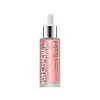What's inside
What's inside
 Key Ingredients
Key Ingredients

 Benefits
Benefits

 Concerns
Concerns

 Ingredients Side-by-side
Ingredients Side-by-side

Cyclopentasiloxane
EmollientC15-19 Alkane
SolventDimethiconol
EmollientAscorbyl Tetraisopalmitate
AntioxidantCaprylic/Capric Triglyceride
MaskingOryza Sativa Bran Oil
EmollientPrunus Amygdalus Dulcis Oil
Skin ConditioningTocopheryl Acetate
AntioxidantBrassica Campestris Seed Oil
Skin ConditioningParfum
MaskingGlycyrrhiza Glabra Root Extract
BleachingPolyglyceryl-3 Diisostearate
EmulsifyingSpilanthes Acmella Flower Extract
Skin ConditioningCitronellol
PerfumingAlthaea Officinalis Root Extract
Skin ConditioningOryza Sativa Bran Extract
Skin ConditioningAlpha-Isomethyl Ionone
PerfumingLimonene
PerfumingGeraniol
PerfumingPolymethylsilsesquioxane
Diamond Powder
AbrasiveCyclopentasiloxane, C15-19 Alkane, Dimethiconol, Ascorbyl Tetraisopalmitate, Caprylic/Capric Triglyceride, Oryza Sativa Bran Oil, Prunus Amygdalus Dulcis Oil, Tocopheryl Acetate, Brassica Campestris Seed Oil, Parfum, Glycyrrhiza Glabra Root Extract, Polyglyceryl-3 Diisostearate, Spilanthes Acmella Flower Extract, Citronellol, Althaea Officinalis Root Extract, Oryza Sativa Bran Extract, Alpha-Isomethyl Ionone, Limonene, Geraniol, Polymethylsilsesquioxane, Diamond Powder
Water
Skin ConditioningPropanediol
SolventGlycerin
HumectantPolysorbate 20
EmulsifyingPhenoxyethanol
PreservativeAmmonium Acryloyldimethyltaurate/Vp Copolymer
Benzyl Alcohol
PerfumingMica
Cosmetic ColorantHydroxyethyl Acrylate/Sodium Acryloyldimethyl Taurate Copolymer
Emulsion StabilisingSqualane
EmollientAletris Farinosa Root Extract
AntioxidantDisodium EDTA
Parfum
MaskingLimonene
PerfumingPolysorbate 60
EmulsifyingDehydroacetic Acid
PreservativeGeraniol
PerfumingLinalool
PerfumingSorbitan Isostearate
EmulsifyingSodium Hydroxide
BufferingCitral
PerfumingCI 77891
Cosmetic ColorantCI 17200
Cosmetic ColorantCI 19140
Cosmetic ColorantWater, Propanediol, Glycerin, Polysorbate 20, Phenoxyethanol, Ammonium Acryloyldimethyltaurate/Vp Copolymer, Benzyl Alcohol, Mica, Hydroxyethyl Acrylate/Sodium Acryloyldimethyl Taurate Copolymer, Squalane, Aletris Farinosa Root Extract, Disodium EDTA, Parfum, Limonene, Polysorbate 60, Dehydroacetic Acid, Geraniol, Linalool, Sorbitan Isostearate, Sodium Hydroxide, Citral, CI 77891, CI 17200, CI 19140
Ingredients Explained
These ingredients are found in both products.
Ingredients higher up in an ingredient list are typically present in a larger amount.
Geraniol is used to add fragrance/parfum to a product. It is the main component of citronellol. It is a monoterpenoid and an alcohol.
Monoterpenes are naturally found in many parts of different plants.
Geraniol can be found in many essential oils including Rose Oil and Citronella Oil. The scent of Geraniol is often described as "rose-like". Many foods also contain Geraniol for fruit flavoring.
Geraniol can irritate the skin when exposed to air. However, irritation depends on the ability of geraniol to penetrate into the skin. In general, geraniol is not able to penetrate skin easily.
Geraniol is colorless and has low water-solubility. However, it is soluble in common organic solvents.
Like citronellol, it is a natural insect repellent.
2,6-Octadien-1-ol, 3,7-dimethyl-, (2E)-
Learn more about GeraniolLimonene is a fragrance that adds scent and taste to a formulation.
It's found in the peel oil of citrus fruits and other plants such as lavender and eucalyptus. The scent of limonene is generally described as "sweet citrus".
Limonene acts as an antioxidant, meaning it helps neutralize free radicals.
When exposed to air, oxidized limonene may sensitize the skin. Because of this, limonene is often avoided by people with sensitive skin.
The term 'fragrance' is not regulated in many countries. In many cases, it is up to the brand to define this term. For instance, many brands choose to label themselves as "fragrance-free" because they are not using synthetic fragrances. However, their products may still contain ingredients such as essential oils that are considered a fragrance.
Learn more about LimoneneParfum is a catch-all term for an ingredient or more that is used to give a scent to products.
Also called "fragrance", this ingredient can be a blend of hundreds of chemicals or plant oils. This means every product with "fragrance" or "parfum" in the ingredients list is a different mixture.
For instance, Habanolide is a proprietary trade name for a specific aroma chemical. When used as a fragrance ingredient in cosmetics, most aroma chemicals fall under the broad labeling category of “FRAGRANCE” or “PARFUM” according to EU and US regulations.
The term 'parfum' or 'fragrance' is not regulated in many countries. In many cases, it is up to the brand to define this term.
For instance, many brands choose to label themselves as "fragrance-free" because they are not using synthetic fragrances. However, their products may still contain ingredients such as essential oils that are considered a fragrance by INCI standards.
One example is Calendula flower extract. Calendula is an essential oil that still imparts a scent or 'fragrance'.
Depending on the blend, the ingredients in the mixture can cause allergies and sensitivities on the skin. Some ingredients that are known EU allergens include linalool and citronellol.
Parfum can also be used to mask or cover an unpleasant scent.
The bottom line is: not all fragrances/parfum/ingredients are created equally. If you are worried about fragrances, we recommend taking a closer look at an ingredient. And of course, we always recommend speaking with a professional.
Learn more about Parfum